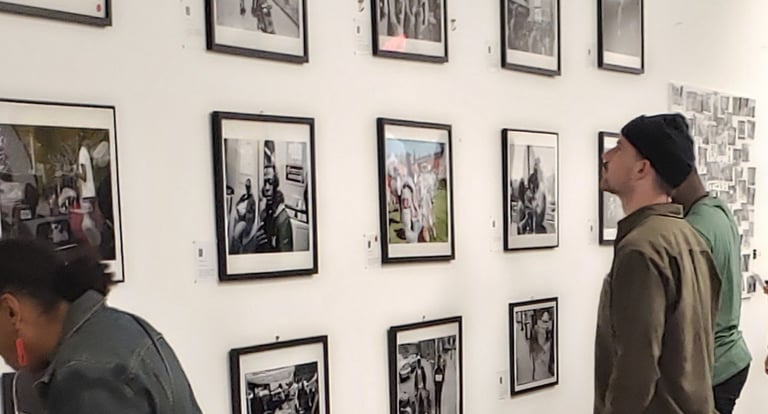By Alaina Coats
Published March 2023
Black and white snapshots taken with love, in-depth precision and attention to detail lined the white walls of documentarian Stanley Johnson’s photography exhibit, “From Decatur, with Love” on the evening of February 25. His monochromatic theme pulled onlookers in and encouraged them to focus on the subjects of his story with keen inquiry.
The exhibit was held at Gallery Anderson Smith, a dapper, single-room gallery cozily tucked away in the heart of the ATL’s bourgeois, Buckhead commercial district. The crowd was thick, the irony perfect.
Uptown meets downtown; Black people’s lives displayed in pictures and popularized by an upscale society.
“I’m from Decatur but I represent Atlanta,” Johnson told Edition8 after a brief break away from the hundreds of admirers who dropped in to see his work. “I think that it’s important for Black people to see themselves in the art as well as learn more about the art form.”
Johnson’s one-day photography exhibition presented a narration of Black Indigenous People of Color’s (BIPOC) experiences in the “A.” Atlanta, GA, already a city of captivating experiences, can’t outshine its people, many whom Johnson has freeze-framed in mid-motion. The people of Atlanta attract gazing stares that are only permissible by way of a craft like Johnson’s photography. And he is pleased to present a snippet of that daily BIPOC life and experience through an uncompromised lens.
BIPOC art is a celebration of Black Indigenous People of Color through various art forms. It’s unique in itself because BIPOC artists are most often of the BIPOC diaspora and embrace the idea that their art can only be authentically shared with the world through the perspectives of their community. Amid the stereotypes and misconceptions, the BIPOC artist controls the narrative of the people.
Johnson’s “From Decatur, with Love” exhibit is a love letter to the BIPOC residents of Atlanta, GA and communities around the world. The project is an expression of Johnson’s heart and his love for Black culture and community. BIPOC live, love, struggle and work just like any other race of people. And Johnson’s work unapologetically makes their lifestyles visible. The subjects of Johnson’s photography are a crisp and clear focal point, central to his message. The homogenous, black and white renders the idea that the images in the photos are real and not overpowered by distracting color swatches.
His captured moments are not staged. They depict the true existence of community in the midst of life’s challenges and adversities like social inequality, police brutality, racism, poverty, loss, grief, etc.
“The black and white concept is a favorite of mine because it draws you in. It makes you pay close attention and you get to see the picture for what it is,” Johnson said of his signature technique.
The gallery’s large floor windows and incandescent stage lights made it easy for street observers to get a sneak peak of the veteran photographer’s display. And they were immediately drawn in.
Atlanta born and raised, which is a rarity for the melting pot that the city has grown into over the years, Johnson’s artistry is 20 years in the making. His work is not just a documentary of the lives of African Americans living on the east and south sides of Atlanta but it also portrays a personal journey of his own experiences as a Black man living and raising a family in metro-Atlanta. “I love Atlanta. It’s my hometown.” Johnson said. This city “cultivates a curiosity to explore the world and document everyday life, especially the lives of those who look like me,” he said. “I want to tell honest stories to help people understand how we experience the world.”
Upon entry into the venue, guests were welcomed by soulful beats prepared by Atlanta DJ, DJ Pre$$tige. Frankie Beverley, Anita Baker and Beyoncé blared through the large speakers that sat at the gallery’s entrance ushering folk in to enjoy the gathering. The scene encapsulated the essence of Johnson’s work: people of all kinds united through love and a shared appreciation of their differences. Johnson’s use of cultural music was a nice touch to bridge that gap.
Close by his side was his wife who is a huge inspiration for his work. One of Johnson’s favorite portraits is of him and his wife poised in regality, exemplifying the strength of Black Love. My wife “believed in me even when I didn’t believe in myself. None [of my work] would be possible without [her],” Johnson said in a recent social media tribute to his wife and village of supporters.
A couple of Johnson’s other favorite pieces include two different portrayals of two teenaged boys playing on unlikely “playgrounds. ”The first one entitled “Donnelly and Lee” depicts an innocent teen popping a wheelie on his bicycle as he crosses the intersection of Donnelly Avenue and Lee Street in West End, Atlanta. The other, entitled “Crossover + hesi” shows another teen draped in a hoodie sweatshirt, jeans and wearing flip-flops dribbling a basketball on the city sidewalk by himself. Both portraits portray Black children straddling the tensions of urban city living, maturity and youthfulness. Johnson channels the truth of their complex and diverse lives through his artistic lens.
Johnson photographs, prints and scans all of his work. That way he’s certain he’s presenting an authentic and accurate representation of the culture and community in any city that he visits. “From Decatur, with Love” is Johnson’s second solo exhibition. His debut exhibition was in 2017 when he showcased the “Black Dad Project.”
Johnson’s photography ranges in price from the low $100s to the high $500s. Johnson attended Chamblee High School and is an alum of Georgia Southern University. For more information visit his website at stanjohnson.co.



